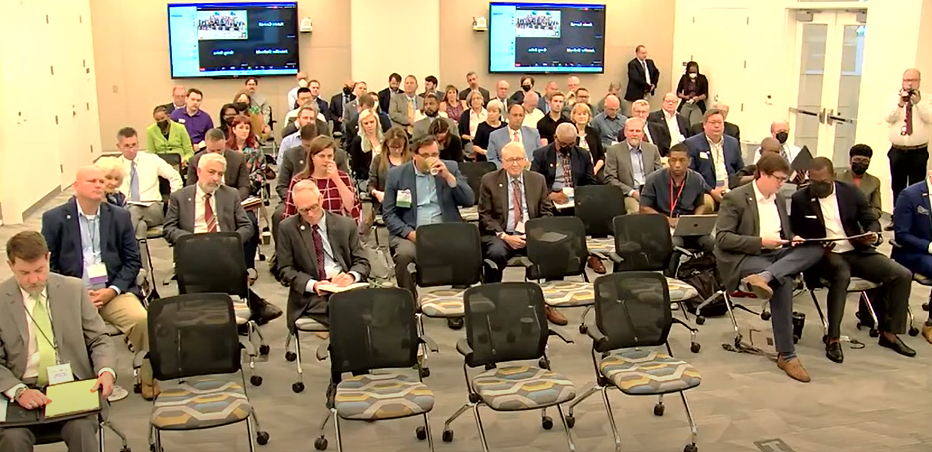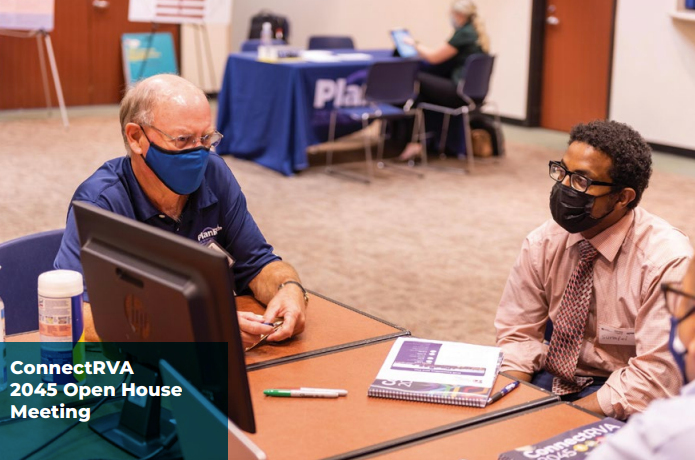Recap: Leaders share state of transportation in Central Virginia during annual meeting

Earlier this month, the Richmond Regional Transportation Planning Organization (RRTPO) hosted a first-of-its-kind joint meeting with the Central Virginia Transportation Authority (CVTA) and PlanRVA to share updates on current and future transportation projects in the greater Richmond region.
View a recording of the meeting.
Here are four takeaways from the event:
"We're going to make some progress on 64".
Virginia Secretary of Transportation W. Sheppard Miller III kicked off the meeting with an update on the I-64 expansion project, which would add capacity to a 29-mile stretch of the interstate between New Kent and James City counties, the last section of the corridor in need of widening.
The project is expected to cost approximately $750 million, supported through a mix of federal and state dollars. The Virginia General Assembly included $320 million plus an additional $150 million option in funding for the project in its recently adopted budget, which is headed to the Governor’s desk. Secretary Miller asked for financial support for the project from CVTA to help reach the full cost and leverage federal grants to move the project forward.
Secretary Miller noted how the project would bring jobs and economic opportunities to the region, especially for underserved rural communities near the proposed widening project. He also emphasized how I-64 is an important route for nearby companies, the Port of Virginia, and military installations in the Richmond and Hampton Roads regions. Once funding is in place, the project can begin this year, explained Secretary Miller.
“It’s the most important project I see that has statewide and regional consequences,” said Secretary Miller. “We need to get together, join hands and make this thing happen.”
The CVTA is making our region more competitive
Established by the Virginia General Assembly in 2020, the CVTA directs funding for priority transportation investments across the region.
“The CVTA allows the nine jurisdiction members of PlanRVA to plot their own course and to have more ownership of transportation investments in Central Virginia,” explained Frank J. Thornton, CVTA Chair and Henrico County Board of Supervisors Member.
The CVTA is funded through slightly higher taxes on fuel and other purchases. For every dollar raised, 50 cents supports local projects, 35 cents funds regional projects and 15 cents supports regional transit.
Without the CVTA, important projects would take years to move forward, according to Thornton.
The Fall Line Trail, a 43-mile north-south regional trail that stretches from Ashland to Petersburg, was one of the first regional projects funded by the CVTA.
“[The funding] helped us jumpstart the trail and leverage other funding,” said Todd Eure, Chair of the CVTA Technical Advisory Committee.
Eure estimated that half of the funding for the Fall Line has already been secured.

Planning and data make our region safer and more accessible
Several RRTPO Technical Advisory Committee members shared updates during the meeting about efforts to make the region’s transportation infrastructure safer and more accessible.
For example, ConnectRVA 2045, a long-range transportation plan that guides the region’s transportation investments for all modes of travel including transit, highways, bicycles and pedestrians, was adopted in October of 2021.
In May, RRTPO leaders greenlighted BikePedRVA 2045, a standalone component of ConnectRVA 2045 tied to recommendations for activating bicycling and pedestrian transportation throughout the region. The plan calls for an additional 770 miles of bicycle and pedestrian infrastructure.
Chet Parsons, PlanRVA’s Director of Transportation, provided an overview of the Richmond Regional Transportation Safety Plan, which was updated earlier this year and approved by the RRTPO in February. The plan emphasizes a regional strategy of “Towards Zero Deaths,” which aims to eliminate serious injuries and deaths on our region’s roadways.
Parsons explained how all of the organization’s transportation planning is rooted in data to inform strategies.
“Regional planning is happening every day.”
PlanRVA has been the home of cooperation among the nine jurisdictions of Central Virginia for more than 50 years.
The organization has put a bigger focus on engaging the wider community recently, explained Christopher Winslow, PlanRVA Commission Chair and Chesterfield Board of Supervisors Chair.
He noted how PlanRVA hosts more than 100 community meetings per year and is working on enhancing its community engagement plan.
PlanRVA continues its work to bring regional leaders to the table as well.
“Regional planning is happening every day,” said PlanRVA Executive Director Martha Heeter. “The work that our localities need to do together – all of it is happening on a daily basis.”
Heeter noted how she sees leaders across jurisdictions frequently partnering on projects large and small. The work is helping the region more effectively tackle issues like community development, emergency management and transportation.
“Cooperation is happening every day among our administrators, department heads and elected officials,” said Heeter.
Subscribe to The Better Together Connector
Sign up to receive The Better Together Connector, a quarterly e-newsletter designed to highlight the latest efforts, successes and a look ahead from PlanRVA, the Central Virginia Transportation Authority, the Richmond Transportation Planning Organization, and the Emergency Management Alliance of Central Virginia.

